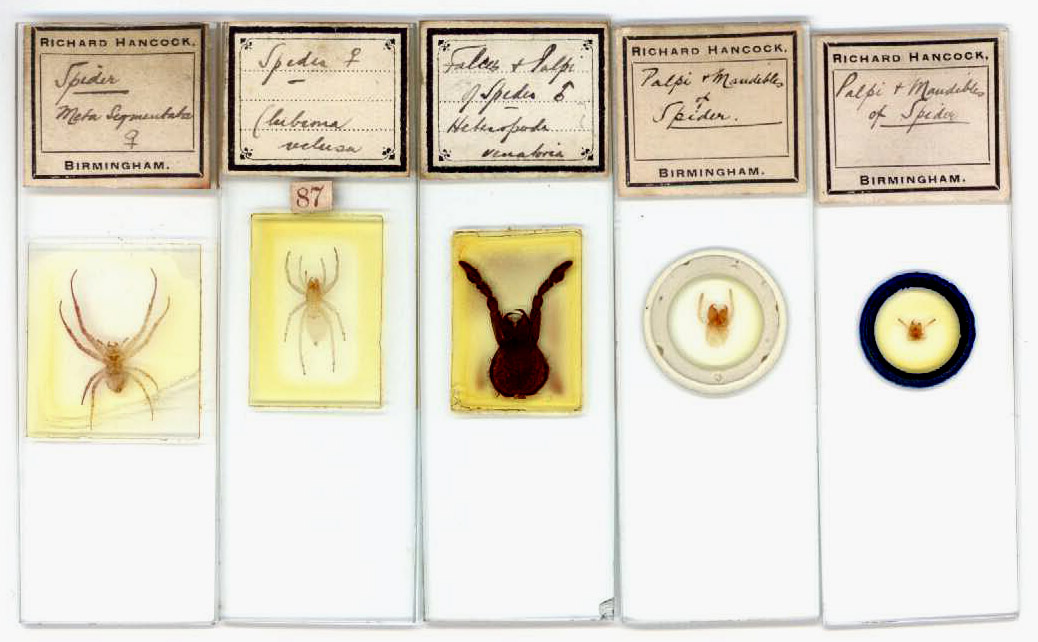
Richard Hancock, 1870 – 1952
by Brian Stevenson
last updated August, 2012
Richard Hancock was an amateur naturalist, microscopist and collector of a diverse range of objects, described by a colleague as “a plumpish auctioneer from Birmingham.” Hancock is best known to microscopists for his excellent mounts of spiders (Figure 1). Arachnology, the study of spiders, was a long-time interest of Hancock’s, and he made numerous contributions to the field. Hancock also mounted a variety of insects and insect parts, plants and animal tissues (Figures 2 and 3). He was an active member of the Birmingham Microscopists’ and Naturalists’ Union prior to 1900, and was producing slides for exchange by that date. One known slide includes the date 1902, written by Hancock (Figure 3). Historical evidence suggests that Hancock’s microscope slides were made by him between the mid-1890s until probably no later than 1910. I did not find any evidence to suggest that Hancock was a commercial preparer – all his microscope slides appear to have been for his personal use or for exchanges with/donations to other microscopists.

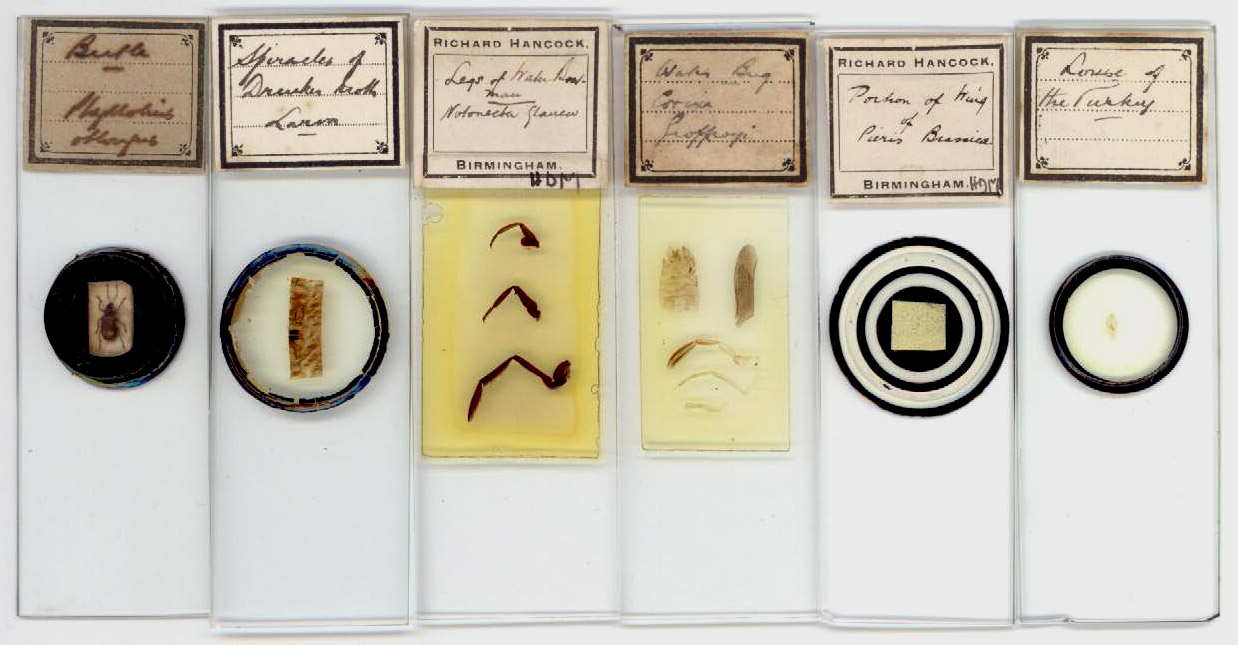
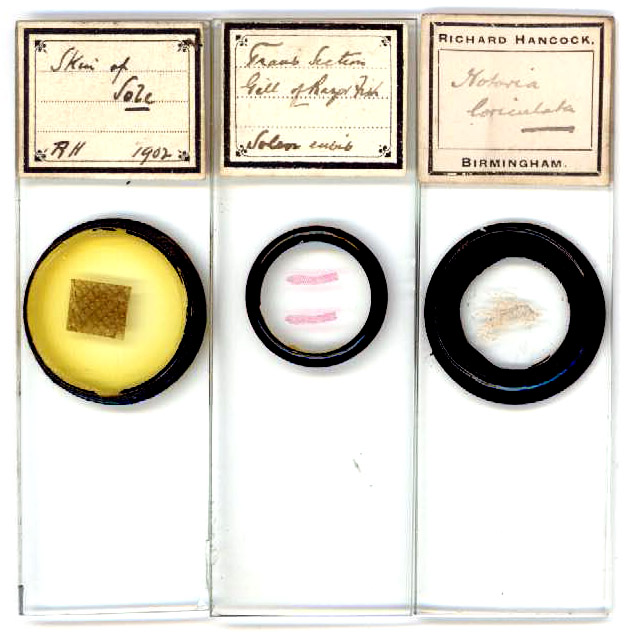
Richard Hancock was born in Birmingham, Warwickshire, during October, 1870. He was the third of five children born to Richard and Martha Hancock. The father was listed on the 1871 and 1881 censuses as having been a clerk in an undefined factor’s office, and in 1891 as a clerk for a jeweler. The eldest son, John, became a gold jeweler. By 1891, the 20-year old Richard was a clerk for an auctioneer. He appears to have continued working primarily as a professional auctioneer throughout his life.
The earliest non-government record yet known was an advertisement in the March, 1892 Phonetic Journal, offering “Books on Physiology, Astronomy, Physiography; also Medical and other books; sell cheap to clear. Send stamp for list. R. Hancock, Northampton st., Birmingham.” Hancock was later described as having been a collector of many things, and it appears that he had started early in his life. Being a professional salesman, it is possible that many of the books he was selling had been acquired with that purpose in mind. >Yet, he evidently had read at least some of them, as he presented a lecture entitled “A short review of Astronomy during the Century” to the Birmingham Microscopists’ and Naturalists’ Union on July 24, 1899.
Richard Hancock served as Secretary of the Birmingham Microscopists’ and Naturalists’ Union in 1901, and held that office for several years thereafter. His election to office implies active participation in the club for some time prior to 1901. Two other well-known microscope slide makers were also members of the Union. James Neville, a prolific amateur who is famous for his elaborately decorated microscope slides, served as secretary until his death in 1900. Professional slide maker Herbert Darlaston bacame a member in about 1892.
In 1900, Hancock requested the following exchange in Science Gossip: “Wanted : Termites (in spirit preferred). Would exchange microscopic slides to value,—R. Hancock, Thornhill End, Handsworth. Birmingham.” Although he did not explicitly state the source of those slides, the example shown in Figure 3 that was dated 1902 makes it reasonable to conclude that Hancock produced the offered slides himself.
Hancock sent 50 of his entomological microscope slides to the Lancashire and Cheshire Entomological Society in October, 1904. The slides were accompanied by a letter suggesting that the Society form a cabinet of such slides, for which the Hancock slides would form a nucleus. The microscope slides were described by the Society as being “very beautiful.”
Richard Hancock’s collections of natural history objects and his expertise benefitted numerous biologists during the early 1900s. John J. Ward, writing on “Insect Weapons and Tools - Some Revelations of the Microscope” for The Pall Mall Magazine in 1901, acknowledged “I am indebted to…Mr. R. Hancock, of Handsworth, Birmingham, for a number of objects which I have photographed.” Another entomology article, in Good Words, 1902, stated “I am obliged to Mr. R. Hancock, of Handsworth, Birmingham, for the use of his excellent parasite specimens, photographs of which I have made.” John Ward dedicated his 1904 book Minute Marvels of Nature: “To Richard Hancock, Honorary Secretary of the Birmingham Microscopists’ and Naturalists’ Union I inscribe this slight introduction to one of Nature’s inexhaustible sources of wonder and fascinating interest as an appreciation of his knowledge, skill, kind sympathy, and valued friendship,” and wrote in the preface “I have to acknowledge the kindness of…Mr. R. Hancock, of Handsworth, Birmingham, for the various preparations shown in Frontispiece and Figs. 27, 28, 29, 38, 104, 112, 116, 118, 123, 124, 125, 127, 130, 144, 147, and 161.” For his 1907 book Wild Life on Norfolk Estuary, Arthur Patterson benefitted from Hancock’s expertise, and stated “On my forwarding these parasites to Mr. R. Hancock, of Birmingham, he identified them as Trinotum (sic) luridum, one perfect, the other two in varying stages of growth. He informs me that this parasite has been found on the wigeon (sic), golden eye, pintail, teal, smew, and goosander.” Two bulletins published on spider identification by the State University of New York (USA), in 1924 and 1928, each noted that “Richard Hancock of Birmingham, England, has been especially helpful in securing specimens of rare species for comparison.”
Frank P. Smith, a notable arachnologist and microscope slide maker, made a presentation of what appeared to be a new species of spider, to the Quekett Microscopical Club on Oct. 20, 1905. He began, “Whilst examining a collection of spiders from Yarmouth, made in August, 1905, by Mr. R. Hancock, of Stechford, Birmingham, I met with a form which appears to me to be new to science, and I take this opportunity of describing and figuring its characteristics. I have great pleasure in naming it in honour of the discoverer.” Six months later, Smith expressed doubts about his naming of Anglia hancockii. He then stated, “I feel pretty confident that the spider described as Anglia hancockii is but a peculiarly coloured specimen of Tmeticus affinis”. Those second thoughts bore true, and the spider is now considered to be Tmeticus affinis, which had been named by Blackwall in 1855.
In a 1908 article on spider behavior, Smith described an exotic species provided to him by Richard Hancock, “A small Eresid from South Africa has highly-developed social habits, large numbers of individuals spinning a common web and killing unwieldy victims by concerted attack. By the kindness of Mr. R. Hancock, of Stechford, I had an opportunity of keeping a colony of these remarkable spiders for a considerable time, and was greatly struck by their curious habits.”
Hancock acquired Smith’s collection after the latter abandoned arachnology and turned his full-time attention to film making. W.S. Bristowe later wrote that Hancock “offered to sell me F.P. Smith’s collection of spiders, microscopes and lantern slides for £100 in 1928. Ultimately he bequeathed all his collections, I believe, to a Birmingham Museum.”I have not been able to track down what eventually happened to Smith’s collection.
Hancock himself wrote a great number of articles, primarily dealing with spiders, other arachnids and insects. Examples include: “A note on the Arenem around Yarmouth” (Zoologist, 1906), “The Drassidae” (Country-side, 1905), “The work of spinning mites” (Country-side, 1905), and “Caddis flies and worms” (Country-side, 1906). A 1905 excursion to collect spiders led to a notable encounter with a duck defending her eggs, entitled “The wild duck’s courage” (Country-side, 1905). The third edition of Popular Fallacies Explained and Corrected quoted Richard Hancock publications from 1922 on the bird-eating spider and from 1924 on web repair by the common garden spider.
Records suggest that photography had taken precedence over microscopy for Hancock by 1910. Many of the Hancock publications noted above included photographs that he had taken. His photographs also accompanied magazine articles by other authors during the period 1905-1910. Hancock produced a travelling, illustrated lecture entitled “Natural History with a Camera.” This presentation was advertised in 1908 by the Bourneville and District Photographic Society as showing “the power of photography as a delineator of nature’s moods. The slides are unique, both as regards subject and quality, so that visitors to the said exhibition are in for a double treat.” By 1908, Hancock had joined the Birmingham Photographic Society, and later served as that club’s secretary. He served as a judge for the Birmingham Field Naturalists' Club photography competition, held August 8, 1908. That same year, Hancock competed in the Amateur Photographer and Photographic News’ Lantern Slide Competition, and earned a silver plaque in the “miscellaneous” class and certificates in both the “portraits and figure studies” and “flowers and still-life” classes. He also won a medal in the lantern slide section of the Edinburgh Photographic Society 1908 Open Exhibition, and exhibited a large number of photographs of spiders and fungi in the Fifty-fourth Annual Exhibition of the Royal Photographic Society of Great Britain, held in 1909. Hancock also provided photographs to naturalist clubs around the country. The Lancashire and Cheshire Entomological Society were provided with “a number of photographs of Lepidoptera, and…a letter relating to the exhibit”, in 1907. In 1911, the South London Entomological and Natural History Society displayed “slides sent by Mr. Hancock, of Birmingham, illustrating the structure, habits, and snares of spiders,” the content indicating that these were lantern slides, not microscope slides. During 1909, Sanders and Co. issued a series of 270 lantern slides by Hancock “illustrating spiders and their habits” (Figure 4). A review in Nature stated that they “show great manipulative and artistic skill. The series, of which a complete catalogue is also published, should be of great use to popular lecturers.” Richard Hancock’s prolific use of the camera, and lack of any later mentions of his involvement with microscopy, suggest that he had ceased making microscope slides before 1910.
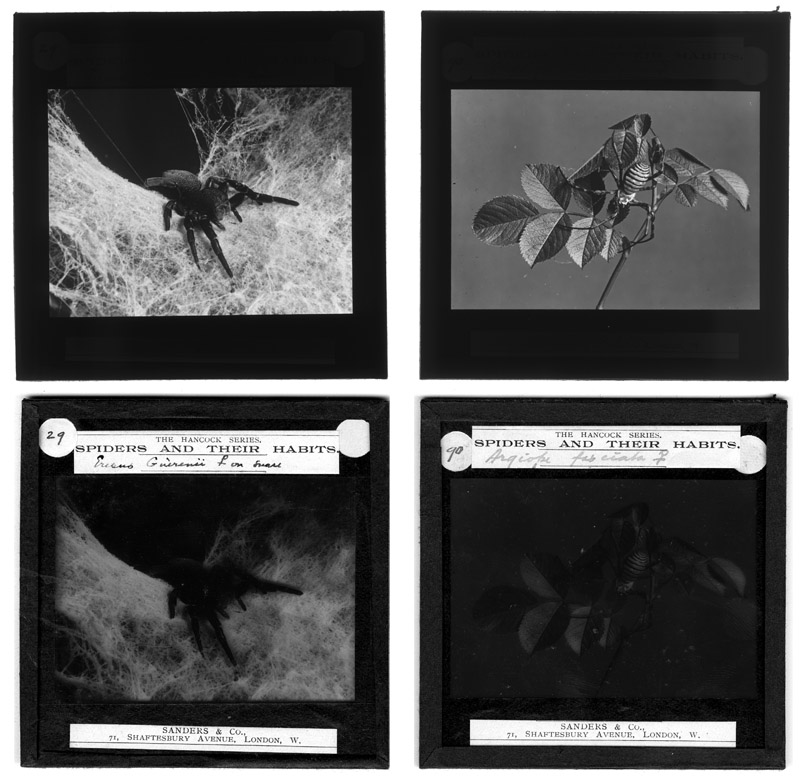
Figure 4. Two of Hancock’s lantern slides of spiders, produced in 1909 by Sanders and Co.
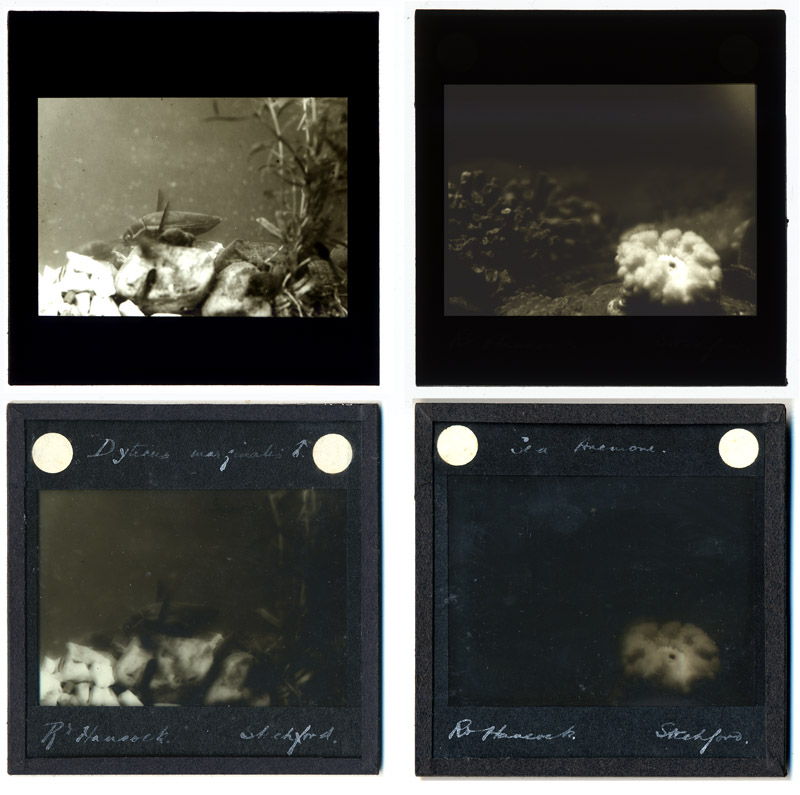
Figure 5. Two additional lantern slides made by Richard Hancock, with his handwritten descriptions. The subjects are a male diving beetle, Dyticus marginalis and an anenome in an aquarium.
Hancock remained active in arachnology and entomology until at least 1929. He read a paper on spiders to the Birmingham and Midland Institute Scientific Society in 1921. Also that year, he advertised in the Bulletin of the Société Royale d'Entomologie de Belgique: “M. Richard Hancock (Aitken Chambers, 1 , Cannon Street, Birmingham) désirerait entrer en relations avec des entomologistes européens désireux d'échanger des.” The 1929 Naturalists’ Universal Directory listed Hancock as an expert on spiders.
Hancock collected many other subject matters, including historical relics and books. During 1931, he exhibited a collection of Oriental pottery to the Birmingham and Warwickshire Archaeological Society. In 1947, Sotheby’s auctioned “a collection of scholarly books, bearing on numismatics, bibliography & printing, entomology, gems, & the fine arts in general, the property of Richard Hancock, Esq., of Birmingham.” He donated an Egyptian limestone stella to the Birmingham Museum in 1931. The Birmingham Public Libraries received “a Collection of 76 volumes, chiefly on Japanese Art, and works in the Japanese language. And several other volumes ” from Hancock in 1939. During 1932, he donated his collection of Japanese tsuba (ornamental sword guards), which was later described in Companion to Japanese Britain and Ireland: “The Birmingham Museum and Art Gallery has a magnificent tsuba collection. Many of the over 200 pieces were the gift of Richard Hancock. Hancock was a successful Birmingham estate agent and valuer and a collector of great expertise.” Two years before that, the Birmingham Museum & Art Gallery acquired “Five hundred Japanese sword-guards, obtained from an eminent Japanese antiquary by Mr. Richard Hancock of Birmingham, who has classified them, have been purchased and presented by Sir Charles Hyde.” Hancock also wrote the 200 page illustrated catalogue for that exhibition in 1930.
Richard Hancock died October 3, 1952, at the age of 81. He had married Annie Eliza Jennens on January 6,1898. They had four children, Richard Alvan Hancock (born 1899), Leolf Hancock (born 1904), Freda Hancock (born 1908) and Neville James Hancock (born 1917).
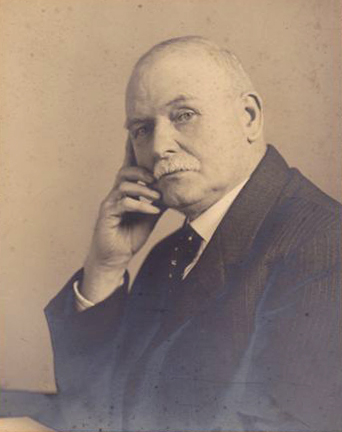
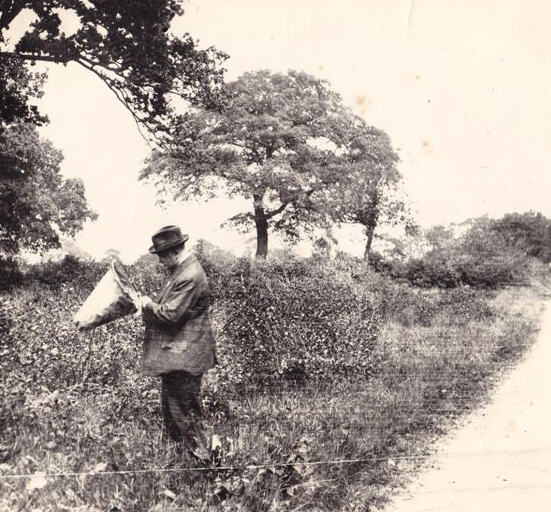
Acknowledgements
My thanks to John Stanney, Honorary Librarian of the British Arachnological Society, for his generous assistance in identifying and obtaining W.S. Bristowe’s works, and to Richard Hancock’s grandson and granddaughter-in-law, Richard and Shirley Hancock, for providing pictures of our microscopist.
Resources
Ackermann, Alfred S.E. (1924) Popular Fallacies Explained and Corrected: (With Copious References to Authorities), Edition 3, Lippincott, pages 344 and 347.
The Amateur Photographer and Photographic News (1908) Vol. 48, pages 65, 384 and 551.
Birmingham Public Libraries (1939) Annual Report, page 6.
Bishop, Sherman C. (1924) A revision of the Pisauridae of the United States (with special reference to the New York species), Issue 252 of Bulletin (New York State Museum and Science Service), The University of the State of New York.
Bristowe, William S. (1951) An introductory chapter on British arachnologists and their work, in British Spiders Vol. 1, edited by G.H. Locket and A.F. Millidge, London pages 1-14.
Bristowe, William S. (1973) Anecdotal notes about our British predecessors, Bulletin of the British Arachnological Society, Vol. 2, pages 193-200.
Bulletin of the Société Royale d'Entomologie de Belgique (1921), page 117
Cassino, Samuel E. (1929) The Naturalists' Directory, page 205
Crosby, Cyrus R., Sherman C. Bishop, and Ralph M. Seeley (1928) Revision of the spider genera Erigone, Eperigone and Catabrithorax (Erigoneae), Issue 278 of Bulletin (New York State Museum and Science Service), The University of the State of New York.
Edinburgh Photographic Society Open Exhibition (1908) Exhibition entries, available on-line at http://www.edinphoto.org.uk/4/4_eps_exhibitions_1908_open.htm
England census, birth, marriage and death records, accessed through ancestry.co.uk
The Entomologist (1907) Lancashire and Cheshire Entomological Society, Vol. 40, pages 44-45.
The Entomologist (1911) The South London Entomological and Natural History Society, Vol. 44, pages 190-191.
The Entomologist's Monthly Magazine (1904) Lancashire and Cheshire Entomological Society, Second series, Vol. 15, pages 283-284.
Exhibition Catalogue of the Fifty-fourth Annual Exhibition of the Royal Photographic Society of Great Britain (1909) Photographs by Richard Hancock, pages 33 and 40-41.
Eyre, Christopher, Arthur F. Shore, Anthony Leahy, Lisa M. Leahy (1994) The Unbroken Reed: Studies in the Culture and Heritage of Ancient Egypt, Vol. 11 of Occasional Publications of the Egypt Exploration Society, page 369.
Good Words (1902) Vol. 43, page 400.
Hancock, Richard (1905) The wild duck’s courage, The Country-side, Vol. 1, page 88.
Hancock, Richard (1905) The Drassidae, The Country-side, Vol. 1, page 169.
Hancock, Richard (1905) The work of spinning mites, The Country-side, Vol. 1, page 269.
Hancock, Richard (1906) A note on the Aranem around Yarmouth, Zoologist, Fourth series, Vol. 10, pages 58-61.
Hancock, Richard (1906) Caddis worms and flies, The Country-side, Vol. 4, page 71.
Hancock, Richard (1930) Catalogue of Tsuba in the Collection of the Birmingham Museum Art Gallery.
The Museums Journal (1931) Birmingham Museum & Art Gallery, Vol. 30, page 60.
Nature (1910) Review of Hancock slides issued by Sanders and Co., Vol. 82, page 43.
Patterson, Arthur H. (1907) Wild Life on Norfolk Estuary, Methuen and Co., London, page 244.
Pearse, Bowen, Christopher McCooey (1991) Companion to Japanese Britain and Ireland, Japan Society (London), page 112.
The Phonetic Journal (Pitman's Journal of Commercial Education) (1892) Advertisement by Richard Hancock, vol. 51, page 176.
Science Gossip (1900) Advertisement by Richard Hancock, New Series, Vol. 7, page 288.
Smith, Frank. P. (1905) Anglia hancockii, a spider new to science, Journal of the Quekett Microscopical Club, Second series, Vol. 4, pages 247-248.
Smith, Frank. P. (1906) The spiders of the Diplocephalus group, Journal of the Quekett Microscopical Club, Second series, Vol. 4, pages 295-411.
Smith, Frank. P. (1908) Some British spiders taken in 1908, Journal of the Quekett Microscopical Club, Second series, Vol. 5, pages 311-334.
Sotheby and Co. (1947) Catalogue of Printed Books Which Will be Sold by Auction on Monday the 3rd of February, 1947, and Two Following Days, London.
Tmeticus affinis (Blackwall, 1855), on-line at The Nearctic Spider Database, http://www.canadianarachnology.org/data/spiders/12934
Transactions of the Birmingham and Warwickshire Archaeological Society (1932), page 132.
Ward, John J. (1901) Insect Weapons and Tools - Some Revelations of the Microscope, The Pall Mall Magazine, Vol. 25, pages 387-394.
Ward, John J. (1904) Minute Marvels of Nature, T.Y. Crowell, New York.
Yearbook of the Scientific and Learned Societies (1895) Birmingham Microscopists’ and Naturalists’ Union, Vol. 30, page 105.
Yearbook of the Scientific and Learned Societies (1900) Birmingham Microscopists’ and Naturalists’ Union, Vol. 43, page 116.
Yearbook of the Scientific and Learned Societies of Great Britain (1901) Birmingham Microscopists’ and Naturalists’ Union, Vol. 44, page 138.
Yearbook of the Scientific and Learned Societies of Great Britain (1903) Birmingham Microscopists’ and Naturalists’ Union, Vol. 46, page 125.
Yearbook of the Scientific and Learned Societies of Great Britain (1921) Birmingham and Midland Institute Scientific Society, page 27.